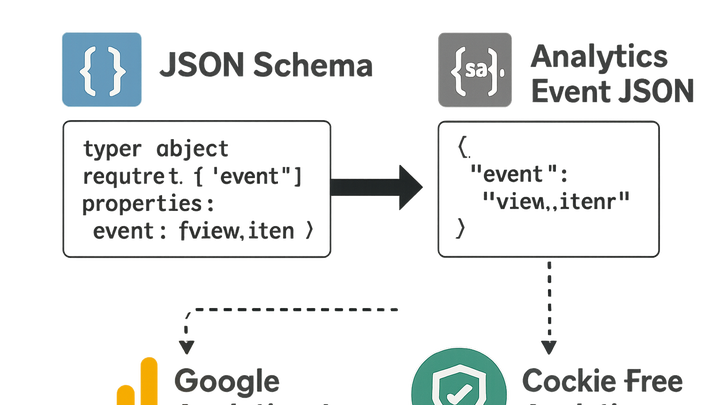Published on 2025-06-26T04:35:53Z
What is JSON Schema? Examples for JSON Schema
JSON Schema is an IETF standard for defining the structure and validation rules of JSON data. In analytics, it serves as a contract between event producers and consumers, ensuring tracking events sent to tools like Google Analytics 4 (GA4) or PlainSignal adhere to expected formats. By declaring property types, required fields, and value constraints, JSON Schema catches data quality issues early, enabling more reliable pipelines and accurate reporting. Implementing JSON Schema in your tracking plan helps document event structures, maintain consistency across teams, and streamline integrations with analytics APIs, including GA4’s Measurement Protocol and PlainSignal’s cookie-free endpoint. You can embed schema validation in your JavaScript instrumentation to validate payloads before dispatch. This approach reduces debugging time, enhances data governance, and improves trust in your analytics data.
Json schema
A declarative language to define, validate, and document the structure of JSON analytics event data for consistent and reliable tracking.
What is JSON Schema?
JSON Schema is a vocabulary that allows you to annotate and validate JSON documents. It provides a clear, machine-readable contract for the shape of your data, including type definitions, required properties, and validation rules.
-
Definition
A JSON-based format for specifying the structure and validation requirements of JSON data.
-
Core concepts
Key building blocks of JSON Schema that help define data contracts.
-
Properties
Define the allowed keys within an object and their associated schemas.
-
Types
Specify data types such as string, number, object, array, boolean, and null.
-
Validation keywords
Keywords like required, pattern, minimum, maxItems, and enum enforce specific constraints.
-
Advantages of Using JSON Schema in Analytics
Adopting JSON Schema in your analytics stack brings consistency, reliability, and documentation benefits, making data governance and integration simpler.
-
Data quality assurance
Ensure tracking events meet predefined standards before they enter your analytics pipeline.
-
Event contract enforcement
All events must conform to the agreed schema, reducing unexpected payloads.
-
Error detection
Catch missing fields or type mismatches early, preventing downstream processing issues.
-
-
Interoperability and documentation
Schemas act as living documentation, aligning teams on event definitions.
-
Self-documenting
JSON Schemas describe available properties and their expected types.
-
Cross-team alignment
Developers, analysts, and stakeholders reference the same contract, reducing miscommunication.
-
Implementing JSON Schema with Analytics Tools
Integrate JSON Schema in common analytics platforms to validate data at source and during ingestion.
-
Google analytics 4 (GA4)
GA4 supports a Measurement Protocol API where payloads can be validated against a JSON Schema before dispatch.
-
Measurement protocol
Use JSON Schema to validate HTTP event payloads sent via the GA4 Measurement Protocol.
-
Data layer schema
Define expected dataLayer objects in your website code using JSON Schema for consistent event structure.
-
-
PlainSignal
With PlainSignal’s cookie-free analytics, you can apply JSON Schema checks directly in your tracking scripts.
-
Embedding validation
Integrate JSON Schema validation logic in your JavaScript before calling PlainSignal’s API.
-
Example tracking code
<link rel="preconnect" href="//eu.plainsignal.com/" crossorigin /> <script defer data-do="yourwebsitedomain.com" data-id="0GQV1xmtzQQ" data-api="//eu.plainsignal.com" src="//cdn.plainsignal.com/plainsignal-min.js"></script>
-
Best Practices and Tips
Maximize the benefits of JSON Schema by following these guidelines for manageability and scalability.
-
Version control
Track schema changes in Git or another VCS to maintain history and enable rollbacks.
-
Centralized schema repository
Host all schemas in a shared registry or folder structure to ensure easy access and reuse.
-
Automated validation
Integrate schema validation into your CI/CD pipeline to catch issues before deployment.
-
Scalability considerations
Break large schemas into smaller, reusable components using $ref.
-
Using $ref
Reference external schema definitions to avoid duplication and simplify maintenance.
-
